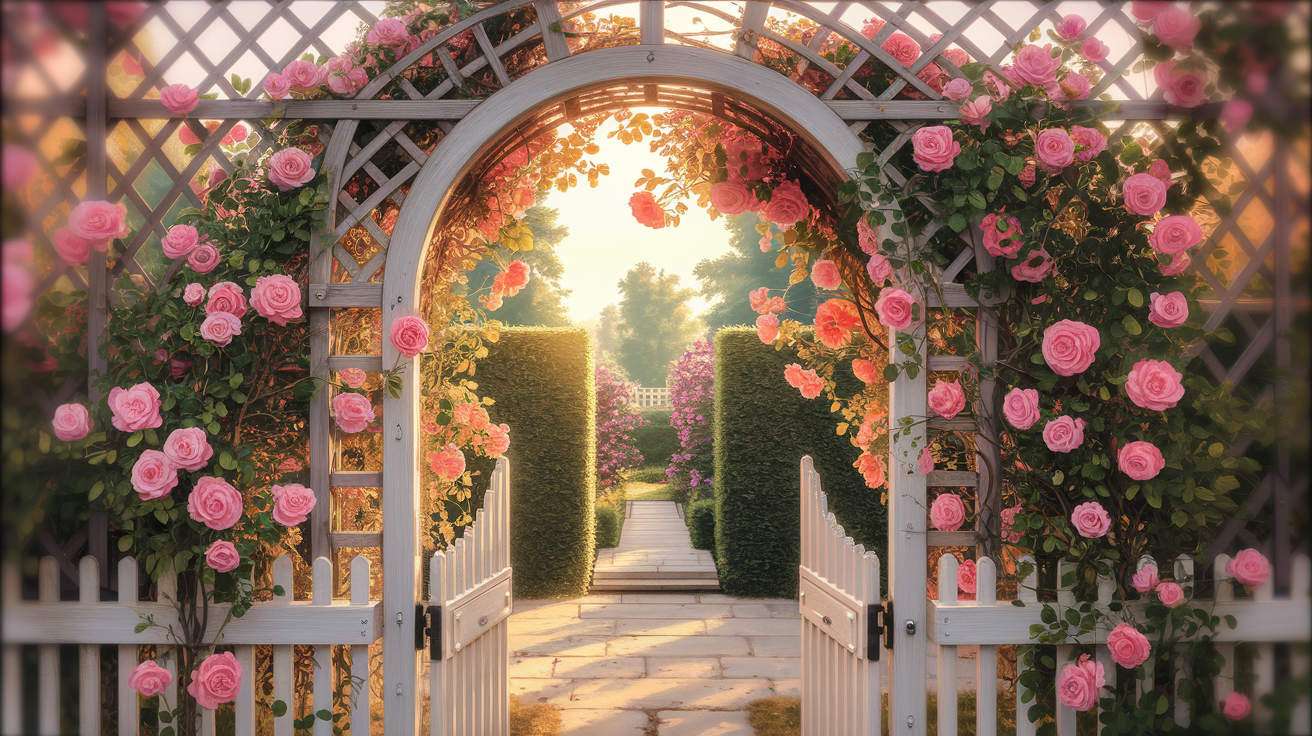A garden gate with an arbor is more than just a functional entryway; it’s a statement piece that can transform your outdoor space’s entire look and feel. Combining beauty with practicality, an arbor-topped gate adds charm and elegance while warmly welcoming anyone who steps into your garden.
Rhys Garden explores the various styles, materials, and benefits of incorporating a garden gate with an arbor into your landscape design, helping you create an inviting and picturesque garden entrance.
What is a Garden Gate with Arbor?
A garden gate with an arbor is a charming combination of two essential garden features: a gate that provides access and security, and an arbor that offers vertical space for climbing plants. This duo creates an inviting entryway that not only enhances your garden’s curb appeal but also serves as a focal point in your landscape design.
To truly appreciate this garden element, let’s break down its components:
- The Gate: Typically made of wood, metal, or vinyl, the gate is the functional part that swings open to allow entry.
- The Arbor: This is the overhead structure that frames the gate. It usually consists of two side posts and a top piece, often in an arch or flat design.
- Lattice or Trellis: Many arbors incorporate lattice or trellis work on the sides or top, providing support for climbing plants.
- Hardware: This includes hinges, latches, and sometimes decorative elements like finials or scrollwork.
Why Choose a Garden Gate with Arbor?
Incorporating a garden gate with arbor into your landscape offers numerous benefits:
- Defines Space: It creates a clear transition between different areas of your garden or property.
- Adds Vertical Interest: The arbor provides height, drawing the eye upward and adding dimension to your garden.
- Supports Climbing Plants: Perfect for clematis, roses, wisteria, or other vining plants, adding color and fragrance to your entrance.
- Enhances Privacy: When covered with plants, it can create a natural screen.
- Increases Property Value: A well-designed gate with arbor can boost your home’s curb appeal.
Choosing the Right Garden Gate with Arbor

Selecting the perfect gate with arbor for your garden involves considering several factors:
Style and Design
Your choice should complement your home’s architecture and your garden’s overall design. Options include:
- Rustic: Perfect for cottage gardens, using natural wood and simple designs.
- Modern: Sleek lines and materials like metal or composite for contemporary landscapes.
- Classic: Traditional designs with ornate details, ideal for formal gardens.
- Asian-inspired: Incorporating elements like moon gates or torii for a zen-like atmosphere.
Materials
The material you choose affects both aesthetics and maintenance:
- Wood: Traditional and versatile, but requires regular maintenance.
- Metal: Durable and low-maintenance, available in various finishes.
- Vinyl: Affordable and low-maintenance, but limited in design options.
- Composite: Combines the look of wood with the durability of synthetic materials.
Size and Proportion
Consider these aspects when determining size:
- Width: Ensure it’s wide enough for comfortable passage and any equipment you might need to move through.
- Height: The arbor should be proportional to your home and garden size.
- Depth: Deep enough to create a sense of passage, typically at least 3-4 feet.
Plant Compatibility
If you plan to grow plants on your arbor, consider:
- Weight-bearing capacity: Ensure the structure can support mature plants.
- Sunlight requirements: Choose a location that meets the needs of your chosen plants.
- Growth rate: Fast-growing plants like morning glories can quickly cover an arbor, while slower growers like climbing roses take more time.
DIY vs. Professional Installation
Deciding whether to build your own garden gate with arbor or hire a professional depends on your skills, time, and budget.
DIY Approach
For the handy gardener, building your own can be a rewarding project:
- Pros: Cost-effective, customizable, personal satisfaction.
- Cons: Time-consuming, requires tools and skills, potential for mistakes.
Professional Installation
Hiring experts ensures a polished result:
- Pros: Professional finish, saves time, expertise in design and construction.
- Cons: Higher cost, less personal involvement in the process.
Maintenance and Care
To keep your garden gate with arbor looking its best:
- Regular Cleaning: Pressure wash or scrub annually to remove dirt and algae.
- Wood Treatment: Apply preservative or paint every 2-3 years to protect wood from the elements.
- Hardware Check: Lubricate hinges and check for rust or loose screws annually.
- Plant Pruning: Regularly trim climbing plants to prevent overgrowth and damage to the structure.
Inspiring Ideas for Your Garden Gate with Arbor
Let’s explore some creative ways to incorporate this feature into your garden:
The Rose-Covered Romance
Create a fairytale entrance with a white picket gate and arbor covered in climbing roses. This classic look never goes out of style and fills your garden with fragrance.
The Modern Minimalist
For contemporary gardens, consider a sleek metal arbor with a simple gate design. Train espaliered fruit trees along the sides for a modern take on traditional techniques.
The Rustic Retreat
Use reclaimed wood and wrought iron hardware for a charming, weathered look. Plant clematis or honeysuckle for a soft contrast to the rugged materials.
The Edible Entrance
Combine beauty and function by growing grapevines or kiwi on your arbor. This creates a shaded walkway and provides a delicious harvest.
The Living Archway
For a truly organic look, use bent saplings or willow to create a living arbor that grows and changes with your garden.
Frequently Asked Questions
To address common queries about garden gates with arbors, we’ve compiled this FAQ section:
Q1: How much does a garden gate with arbor typically cost?
A: The cost can vary widely depending on materials, size, and complexity. A simple DIY wood structure might cost $200-$500 in materials, while a custom-built, high-end metal arbor and gate could run $2,000-$5,000 or more.
Q2: How long does it take for plants to cover an arbor?
A: This depends on the plant species and growing conditions. Fast-growing annuals like morning glories can cover an arbor in a single season, while woody vines like wisteria might take 3-5 years to fully establish.
Q3: Can I install a garden gate with arbor on a slope?
A: Yes, but it requires careful planning. The gate should be level, which may mean stepped posts on a slope. Consider consulting a professional for challenging terrain.
Q4: What’s the best way to secure a garden gate with arbor?
A: Proper installation is key. Posts should be set in concrete at least 2 feet deep. For larger structures, consider using anchor bolts or brackets for additional stability.
Q5: Are there any plants I should avoid growing on my arbor?
A: While most climbing plants are suitable, avoid extremely aggressive growers like kudzu or some varieties of ivy that can damage the structure. Also, consider the weight of mature plants – some heavy woodies like wisteria may require extra sturdy support.
Conclusion
Incorporating a garden gate with an arbor into your outdoor space is a simple yet impactful way to elevate your garden’s aesthetics. Whether you’re aiming for a classic, rustic, or modern look, the right gate and arbor combination can create a stunning focal point that enhances the overall beauty of your landscape. As Rhys Garden, we hope this guide inspires you to design a garden entrance that reflects your style and welcomes you home to a tranquil, beautiful environment every day.

Related Posts
Are Wild Flowers Perennial? Unveiling Nature’s Blooming Secrets
Growing Johnny Jump Up Seeds: A Gardener’s Guide to Viola Tricolor
The Art of Transplanting Japanese Maple